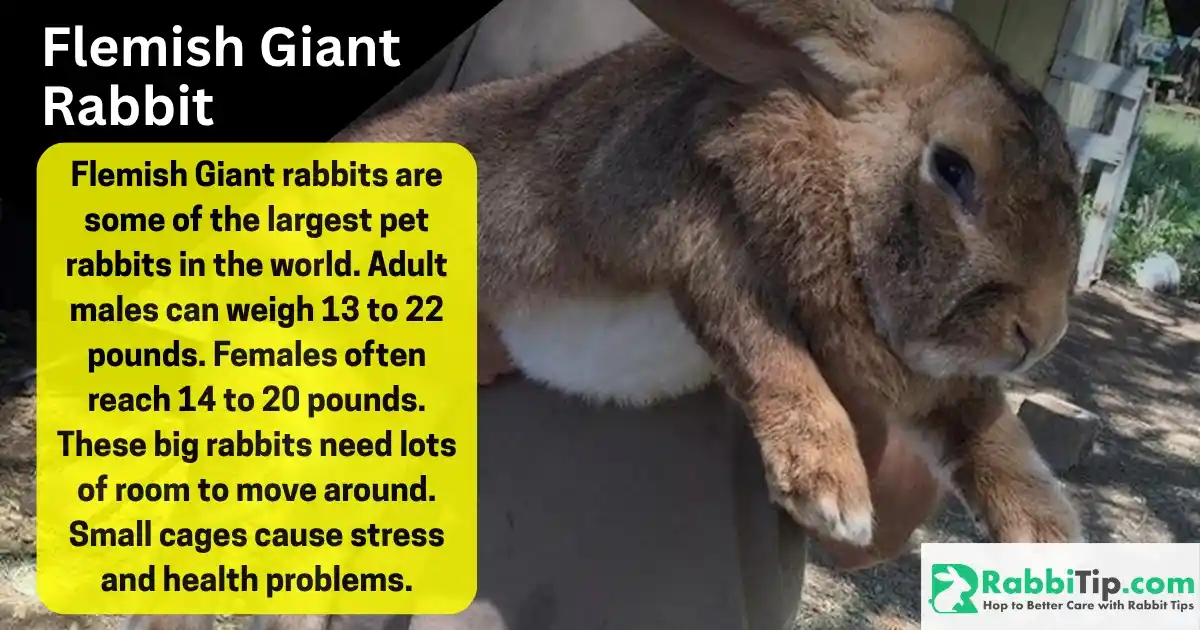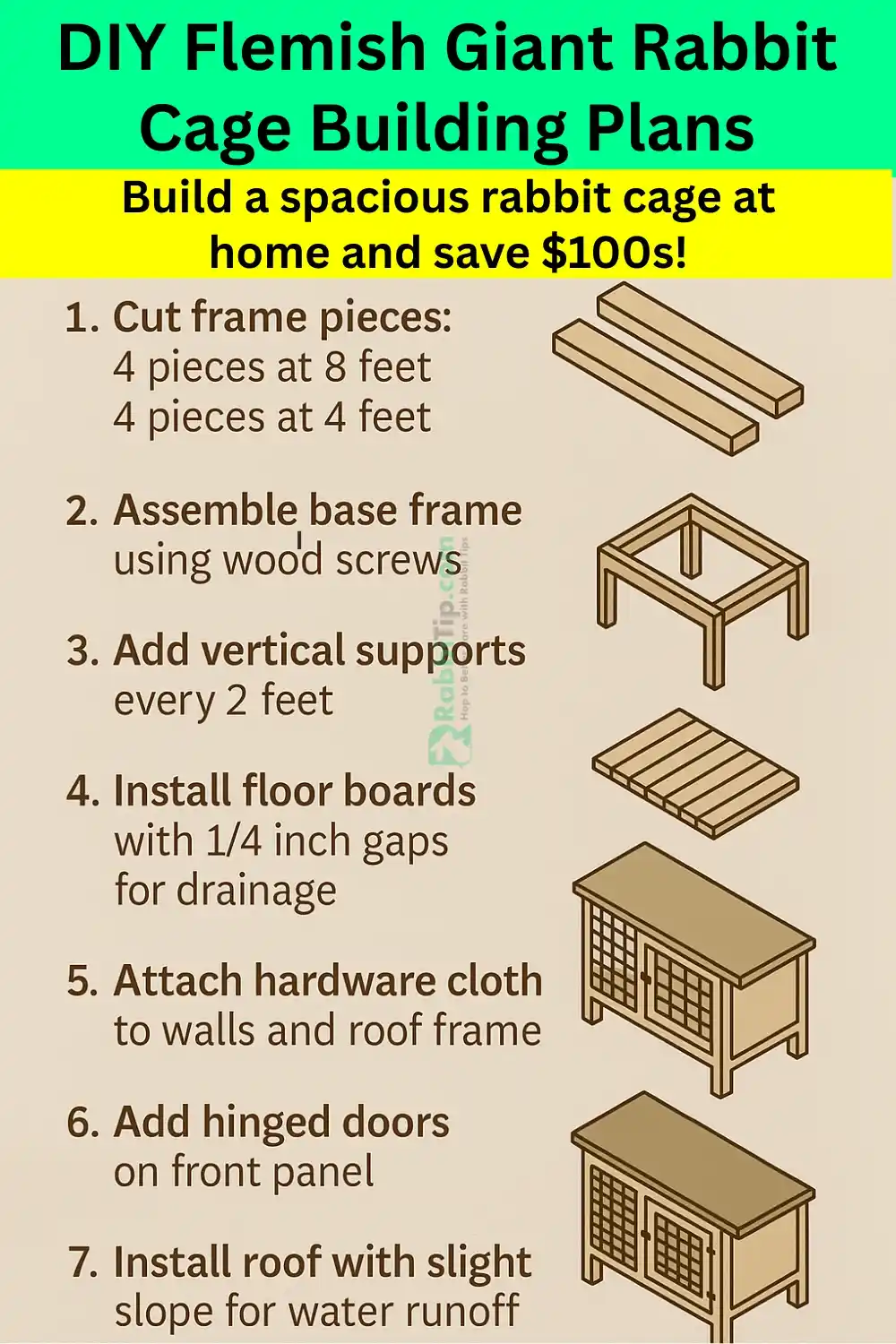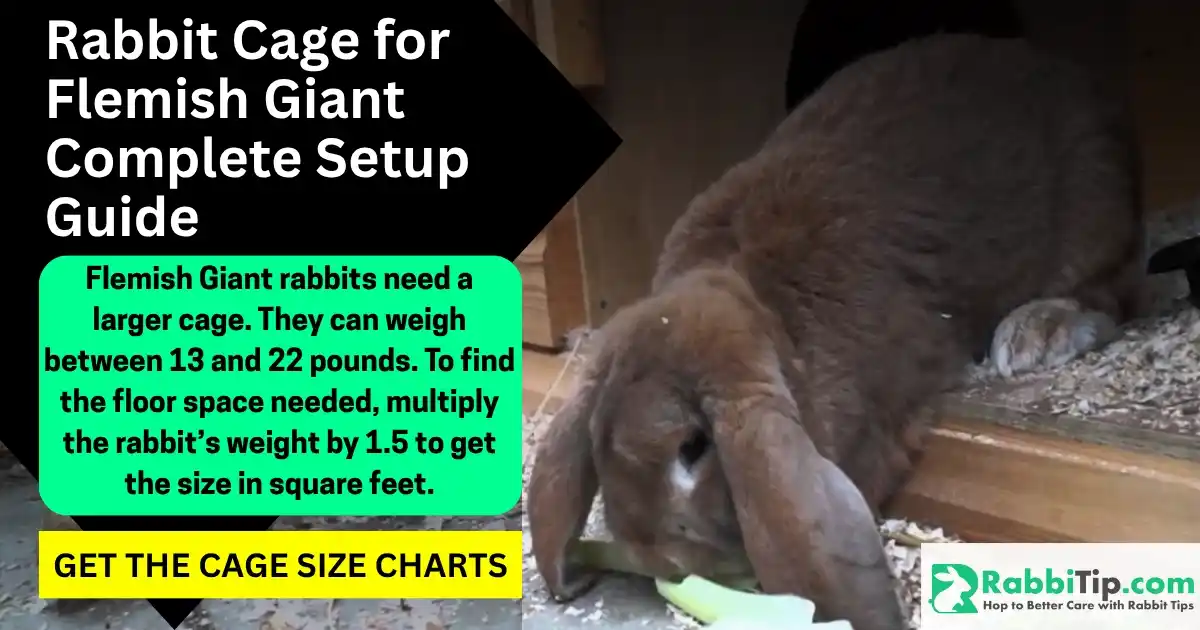A rabbit cage for Flemish Giant breeds requires special size needs. These gentle giants need much more space than normal rabbits. USA rabbit owners love these large breeds for their calm nature. American giant breed fans know proper housing is key to happy pets. Many US breeders focus on giving these rabbits the best homes possible.
The right cage setup helps your Flemish Giant stay healthy and active. USDA-approved cage materials include solid wood floors and wire mesh walls. For detailed information about quality wooden construction, check out our comprehensive wooden rabbit hutch guide. The American Rabbit Breeders Association sets clear standards for cage sizes. These rules help owners give their pets safe, comfy homes. Good cages protect rabbits from weather and predators too.
How Much Space Do Flemish Giant Rabbits Need?
Flemish Giant rabbits are some of the largest pet rabbits in the world. Adult males can weigh 13 to 22 pounds. Females often reach 14 to 20 pounds. These big rabbits need lots of room to move around. Small cages cause stress and health problems.
Flemish Giant rabbits need a larger cage. They can weigh between 13 and 22 pounds. To find the floor space needed, multiply the rabbit’s weight by 1.5 to get the size in square feet.
The basic space rule is simple math. Take your rabbit’s weight in pounds. Multiply by 1.5 square feet. This gives you the minimum floor space needed. For example, a 16-pound Flemish Giant needs at least 24 square feet of floor space. This is just for sleeping and resting areas.
US Size Requirements Calculator:
- Rabbit weight × 1.5 = minimum cage floor space (sq ft)
- Add 50% more space for exercise areas
- Height should be at least 18 inches for sitting up
- Length should allow 3 full hops (about 8-10 feet)
American vets suggest even more space when possible. The House Rabbit Society recommends 8 square feet as an absolute minimum. But this is for much smaller rabbits. Flemish Giants need at least 4 times this amount. Many US rabbit rescues won’t adopt to homes with small cages.
Housing Your Flemish Giant
Weather plays a big role in rabbit housing across America. Cold northern states need different setups than hot southern areas. Flemish Giants handle cold better than heat. But they still need protection from extreme weather. Wind and rain can make rabbits sick fast.
Indoor housing works well in most US climates. Basements stay cool in summer heat. Garages work if they have good air flow. Outdoor hutches need shade in hot states like Arizona and Texas. Northern states like Maine need wind-proof designs. Always check your local weather patterns first.
State Climate Adaptation Guide:
- Northern states: Focus on wind protection and insulation
- Southern states: Prioritize shade and ventilation
- Coastal areas: Add moisture barriers and rust-proof materials
- Mountain regions: Plan for temperature swings and snow loads
ARBA-approved cage features include solid floors and good drainage. Wire floors hurt rabbit feet over time. Wooden slats work better but need regular cleaning. The cage should have separate areas for eating, sleeping, and waste. Multiple levels help save space while giving more room.

Indoor vs Outdoor Housing
Indoor housing gives you more control over your rabbit’s environment. You can keep temperatures steady year-round. Predators can’t reach indoor rabbits. Vet care is easier when rabbits live inside. Many American owners prefer indoor setups for these reasons. Climate control helps prevent heat stroke in summer. Indoor rabbits often live longer, healthier lives too.
Outdoor housing connects rabbits with natural light and fresh air. Many US rural areas have perfect outdoor rabbit weather. Outdoor hutches cost less to build than indoor room setups. Your rabbit gets more natural behaviors outside. But outdoor housing needs more safety planning. Predators like foxes, hawks, and dogs pose real threats across America.
Indoor vs Outdoor Housing Comparison
| Location Type | Safety Risks | Climate Suitability | Cost | Maintenance |
|---|---|---|---|---|
| Indoor | Very Low | Excellent | High Setup | Low Daily |
| Outdoor | Moderate-High | Climate Dependent | Low Setup | High Daily |
| Garage/Shed | Low | Good | Medium | Medium |
| Basement | Very Low | Excellent (Cool) | Medium | Low |
| Screened Porch | Low-Moderate | Good | Medium | Medium |
Suggested Hutches for Your Flemish Giant Rabbit
Commercial hutches save time but cost more money. American-made hutches often use better materials than imports. Local builders understand US weather patterns better. Many hutch companies offer custom sizes for giant breeds. This helps ensure your Flemish Giant has enough space to be comfortable.
Pre-built hutches come in many styles and price ranges. Budget options start around $200 but may be too small. Quality Flemish Giant hutches cost $350 to $850. Premium models can reach $1200 or more. Higher prices usually mean better materials and larger sizes. Always measure before you buy any hutch.
Top 5 American Hutch Brands
| Brand | Price Range | Size Rating | Material Quality | Warranty |
|---|---|---|---|---|
| Advantek | $300-600 | Large | Good | 1 Year |
| Prevue Pet | $250-500 | Medium-Large | Fair | 90 Days |
| Ferplast | $400-800 | Large | Excellent | 2 Years |
| Kaytee | $200-400 | Medium | Good | 6 Months |
| Ware Manufacturing | $300-700 | Large | Very Good | 1 Year |
Enrichment and Accessories
Flemish Giants need mental stimulation to stay happy and healthy. Bored rabbits often develop bad habits like chewing or aggression. American rabbit experts recommend several key accessories for large breeds. Hiding spots help rabbits feel secure. Chew toys keep teeth healthy and minds busy.
Exercise equipment helps prevent obesity in large rabbits. Ramps and platforms add vertical space to cages. Food puzzles make mealtime more interesting. All accessories should be sized for giant breeds. Regular rabbit toys often break under the weight of Flemish Giants.
Must-Have Accessories
| Item | Purpose | ARBA Recommendation | Size for Flemish Giant |
|---|---|---|---|
| Hide Box | Security/Rest | Essential | 24″x18″x16″ minimum |
| Water Bottle | Hydration | Recommended | 32 oz capacity |
| Food Bowl | Feeding | Essential | 8-10 inch diameter |
| Hay Rack | Fiber/Enrichment | Recommended | Large capacity |
| Litter Box | Waste Management | Essential | 24″x18″ minimum |
| Exercise Pen | Additional Space | Highly Recommended | 8-panel minimum |
DIY Flemish Giant Cage Plans
Building your own cage saves money and ensures proper sizing. Many American woodworkers share free plans online. Basic skills and common tools are all you need. Most DIY cages cost $100 to $300 in materials. This is much less than buying pre-made hutches. For those interested in traditional wooden construction methods, our wooden rabbit hutch guide provides additional building techniques and material recommendations.
Start with a simple rectangular design. Use pressure-treated lumber for the frame. Cedar and pine work well for walls and floors. Avoid treated wood where rabbits might chew. Hardware cloth is better than chicken wire for walls. The mesh should be small enough to keep predators out.
Basic Materials List (USDA-Approved):
- Pressure-treated 2×4 lumber for frame
- Cedar or pine boards for solid areas
- Hardware cloth (1/2 inch mesh)
- Galvanized screws and hinges
- Roofing material (metal or shingles)
- Hardware for latches and locks
Step-by-Step Blueprint:
- Cut frame pieces: 4 pieces at 8 feet, 4 pieces at 4 feet
- Assemble base frame using wood screws
- Add vertical supports every 2 feet
- Install floor boards with 1/4 inch gaps for drainage
- Attach hardware cloth to walls and roof frame
- Add hinged doors on front panel
- Install roof with slight slope for water runoff

Flemish Giant Cage Size Charts
Proper sizing prevents health problems and behavioral issues. Under-sized cages cause stress and aggression. Over-crowding multiple rabbits leads to fighting. Use these charts to plan your cage dimensions. Remember these are minimum sizes – bigger is always better.
Single Rabbit Minimum Dimensions:
- Floor space: 30 square feet (6ft x 5ft)
- Height: 24 inches minimum
- Exercise area: Additional 50 square feet
- Sleeping box: 24″ x 18″ x 16″
Breeding Pair Dimensions:
- Floor space: 50 square feet (10ft x 5ft)
- Height: 30 inches minimum
- Separate nesting areas for each rabbit
- Additional space for babies if breeding
Weight-Based Sizing Chart:
| Rabbit Weight | Minimum Cage Size | Recommended Size | Exercise Space |
|---|---|---|---|
| 10-12 lbs | 24 sq ft | 30 sq ft | 40 sq ft |
| 13-15 lbs | 30 sq ft | 36 sq ft | 50 sq ft |
| 16-18 lbs | 36 sq ft | 42 sq ft | 60 sq ft |
| 19-22 lbs | 42 sq ft | 48 sq ft | 70 sq ft |
What to Check When Buying Flemish Giant Rabbit Cage
Safety should be your top priority when shopping for cages. Check all latches and locks carefully. Weak hardware lets rabbits escape or predators enter. Sharp edges can cut your rabbit’s skin. Rust or damage shows poor construction quality. Always inspect cages in person when possible.
Size specifications vary between manufacturers. Some companies measure outside dimensions. Others use inside measurements. Always ask for clarification before buying. Return policies help if the cage arrives too small. Many American pet stores offer satisfaction guarantees.
Pre-Purchase Checklist:
- Measure your available space first
- Check weight limits for multi-level designs
- Verify door sizes for easy rabbit access
- Test latch mechanisms for security
- Inspect wire gauge and spacing
- Review assembly instructions and tools needed
- Confirm warranty coverage and length
Essential Resources: Download our free bunny care sheet PDF for complete Flemish Giant care tips. If you’re planning to transport your rabbit, our rabbit transport cage guide covers safe travel solutions. New rabbit owners should also explore our collection of adorable bunny names to find the perfect name for their gentle giant.
Top 3 Best USA Sites to Buy Flemish Giant Rabbit Cage
Online shopping offers the best selection and prices for rabbit cages. American websites often provide better customer service than foreign sites. Shipping costs can be high for large cages. Some retailers offer free delivery on big orders. Always read customer reviews before purchasing.
1. Chewy.com
Chewy specializes in pet supplies with excellent customer service. They carry many cage brands in Flemish Giant sizes. Free shipping on orders over $49. Easy return policy if cages don’t fit. Customer reviews help you choose the right size.
2. Amazon.com
Amazon has the largest selection of rabbit cages online. Prime members get fast, free shipping. Customer questions and answers help with sizing. Easy comparison shopping between brands. Some items ship directly from manufacturers.
3. Tractor Supply Co.
TSC focuses on farm and rural pet supplies. They understand large rabbit needs better than general pet stores. Many locations let you see cages before buying. Local pickup saves shipping costs. Staff often have rabbit experience.
Frequently Asked Questions
What size cage does a Flemish Giant rabbit need?
A Flemish Giant rabbit needs at least 30 square feet of space. That’s about 6 feet by 5 feet. The cage must be 24 inches tall so the rabbit can sit up. Bigger rabbits need more room to hop and stretch. Add a playpen or open area for extra movement.
Do Flemish Giants need a cage?
Yes, they do. A cage keeps them safe and comfortable. It gives them a place to eat, sleep, and use the litter box. While some rabbits free-roam, cages help avoid danger. Many owners use cages at night and give playtime during the day.
Can you keep a Flemish Giant rabbit in an apartment?
Yes, you can. Use a big playpen or pen instead of a small cage. Make sure the rabbit gets time to run each day. Check your lease before getting a rabbit. Some places don’t allow pets or large animals.
Do Flemish Giants get along with smaller rabbits?
Sometimes. Flemish Giants can live with smaller rabbits if you bond them slowly. Big rabbits can scare or hurt smaller ones by mistake. Let them meet in a neutral area. Watch them closely at first. Give each rabbit its own food and litter space. In the end, it’s about how well their personalities match.

